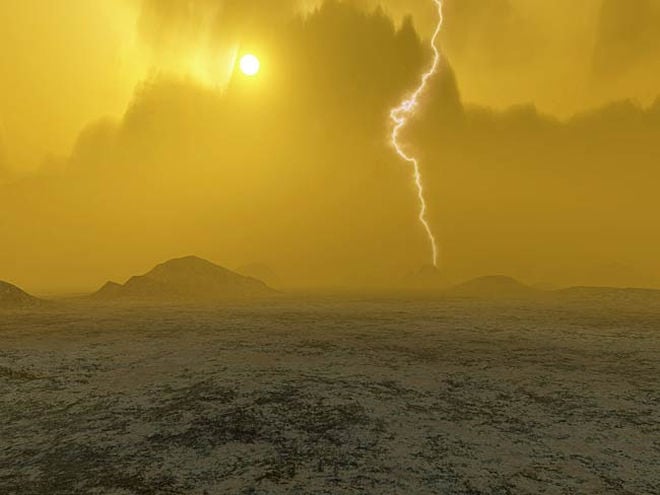
An international team of scientists claim that a superluminous event in a distant galaxy was caused by a star being ripped apart by a supermassive black hole.
Continue reading

Want to buy a green laser but need help choosing one? This guide will help!
Continue reading

For centuries, human beings have been creating mechanical models the Solar System, which today is known as an orrery,
Continue reading

Continue reading

Continue reading

Continue reading

KENNEDY SPACE CENTER, FL - An exciting new chapter in hurricane monitoring and forecasting intensity prediction is due to open Monday morning at NASA's Kennedy Space Center when a new constellation of microsatellites dubbed CYGNSS are slated to be deployed from an air-launched Orbital ATK Pegasus XL rocket.
Continue reading

CAPE CANAVERAL AIR FORCE STATION, FL - The most powerful US Air Force military communications satellite ever built was propelled to orbit by a ULA Delta IV rocket that provided a dinnertime launch delight Wednesday evening for the crowds of spectators gathered around America's premier gateway to space.
Continue reading
Every year, NASA release Spinoff, a publication produced by the Technology Transfer Program that shows how NASA technology has benefits here on Earth.
Continue reading

SpaceX is postponing the resumption of launches for their Falcon 9 rocket into early January 2017 as they continue to deal with the fallout from the catastrophic launch pad explosion in Florida that destroyed a Falcon 9 during preflight test operations three months ago.
Continue reading

Continue reading

A comprehensive guide to astronomical oppositions, occultations, eclipses, comets and more for 2017.
Continue reading

A new study produced by an international team of researchers shows that Dark Matter may be more smoothly distributed than previously thought
Continue reading

Continue reading

Continue reading

It turns out, that famous question of "How do you go to the bathroom in space?" is not so easy to answer. At least, not when it comes to 'going' -- repeatedly -- in your spacesuit, when you may have been wearing it continually for six days or more.
Continue reading

CAPE CANAVERAL AIR FORCE STATION, FL - The highest-capacity US Air Force communications system thundered to orbit during a fabulous nighttime blastoff from the Florida Space Coast, Wednesday evening offering a picture perfect spectacle in addition to a significant boost to military point to point communications.
Continue reading

Trump's recent meeting with Al Gore in New York has fueled speculation about the future of NASAs Earth science missions, which are demonstrably vital to the nation
Continue reading

Continue reading

Continue reading

Earth's familiar gravity - which is 9.8 m/s², or 1 g - is both essential to life as we it, and an impediment to us becoming a true space-faring species!
Continue reading

The Cassini mission has begun its final phase and has completed its first ring-grazing orbit around Saturn.
Continue reading

Continue reading

Buzz Aldrin - the second man to walk on the Moon - is recovering nicely today in a New Zealand hospital after an emergency medical evacuation cut short his record setting Antarctic expedition as the oldest man to reach the South Pole - which Team Buzz lightheartly noted would make him "insufferable" !
Continue reading

The ESO has released spectral data obtained by the Very Large Telescope, which studied a distant qausar to determine how electromagnetism works.
Continue reading

Continue reading

Only three months after the catastrophic launch pad explosion of their commercial Falcon 9 rocket in Florida, SpaceX has set Dec. 16 as the date for the boosters 'Return to Flight' launch from California with the first batch of Iridium's next-generation communications satellites.
Continue reading

The weather on Venus is incredibly hostile, characterized by extreme temperatures, acid rain, lightning storms and powerful winds.
Continue reading

KENNEDY SPACE CENTER, FL - An unmanned Russian Progress resupply ship bound for the International Space Station (ISS) was lost shortly after launch from the Baikonur Cosmodrome in Kazakhstan on Thursday when its Soyuz booster suffered a catastrophic anomaly in the third stage, and the craft and its contents were totally destroyed.
Continue reading

The Asteroid Belt, which rests between the orbits of Mars and Jupiter, orbits our Sun at a distance of 3.2 to 4.2 times the distance between the Earth and the Sun
Continue reading

Continue reading

In the northern sky, bordered by Ursa Major and Boötes, lies the small constellation of Canes Venatici, one of the 88 constellations recognized by the IAU.
Continue reading

According to the Standard Model of Particle Physics, all matter is composed is hadrons (which are made up of elementary particles) and leptons, which are elementary particles themselves.
Continue reading

Sky Canvas plans to launch a colorful artificial meteor shower barrage via micro-satellite.
Continue reading

Valentina Tereshkova was the first woman to go into space, blazing a trail for all the female astronauts and cosmonauts who have since followed.
Continue reading

Not all stars are alone. Some come in pairs and more. And when there are multiple stars in a system, watch the cosmic sparks fly.
Continue reading

A new study released by the Radiological Society of North America has determined why astronauts who take part in long-duration missions experience problems with their eyesight.
Continue reading

Continue reading

Radar mapping of San Francisco's Bay Area has verified the slow sinking of a luxury skyscraper.
Continue reading

For decades, astronomers have believed that a supermassive black hole exists at the center of our galaxy. And ongoing research has shown that it is not alone!
Continue reading

Continue reading

Located in the direction of the Sagittarius Constellation, roughly17,900 light-years from Earth, lies the globular cluster known as Messier 28.
Continue reading

Using the same kind of light and detection ranging (lidar) technology as the OSIRIS-REx missions, archaeologists are uncovering secrets of Earth's distant past.
Continue reading

After months of research, the IAUs Working Group on Star Names has released a catalog that restored the assigned traditional names to 227 stars
Continue reading

The Cydonia region of Mars has been the subject of scientific and popular curiosity for decades, thanks mainly to its famous "Face of Mars".
Continue reading

Continue reading

Investigators have made progress into determining the cause of the Schiaparelli accident, which appears to be due to a temporary error with one of the on-board instruments.
Continue reading

KENNEDY SPACE CENTER, FL - The fire and fury of the mighty Atlas V got the gorgeous NASA/NOAA GOES-R weather observatory to geostationary orbit just days ago - as a 'Thanksgiving' present to all the people of Earth through the combined efforts of the government/industry/university science and engineering teams of hard working folks who made it possible.
Continue reading

We've been so busy wondering how we'll find aliens that we never stopped to consider what we'll do if we actually encounter them. How does an alien discovery get communicated to the media? Who's responsible to craft a response?
Continue reading

Located beneath the border between France and Switzerland is the CERN Particle Accelerator, the largest instrument of its kind in the world.
Continue reading

 Universe Today
Universe Today













































